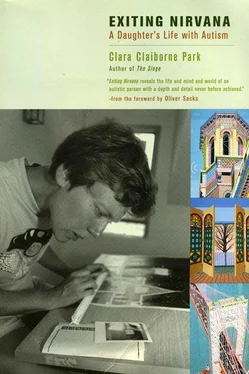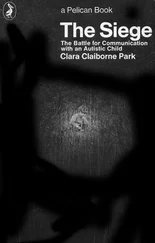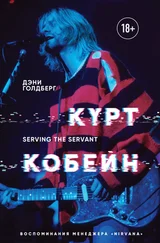Clara Park - Exiting Nirvana
Здесь есть возможность читать онлайн «Clara Park - Exiting Nirvana» весь текст электронной книги совершенно бесплатно (целиком полную версию без сокращений). В некоторых случаях можно слушать аудио, скачать через торрент в формате fb2 и присутствует краткое содержание. ISBN: , Жанр: Психология, на английском языке. Описание произведения, (предисловие) а так же отзывы посетителей доступны на портале библиотеки ЛибКат.
- Название:Exiting Nirvana
- Автор:
- Жанр:
- Год:неизвестен
- ISBN:0-316-69117-8
- Рейтинг книги:4 / 5. Голосов: 1
-
Избранное:Добавить в избранное
- Отзывы:
-
Ваша оценка:
- 80
- 1
- 2
- 3
- 4
- 5
Exiting Nirvana: краткое содержание, описание и аннотация
Предлагаем к чтению аннотацию, описание, краткое содержание или предисловие (зависит от того, что написал сам автор книги «Exiting Nirvana»). Если вы не нашли необходимую информацию о книге — напишите в комментариях, мы постараемся отыскать её.
All illustrations are by Jessy Park.
Exiting Nirvana — читать онлайн бесплатно полную книгу (весь текст) целиком
Ниже представлен текст книги, разбитый по страницам. Система сохранения места последней прочитанной страницы, позволяет с удобством читать онлайн бесплатно книгу «Exiting Nirvana», без необходимости каждый раз заново искать на чём Вы остановились. Поставьте закладку, и сможете в любой момент перейти на страницу, на которой закончили чтение.
Интервал:
Закладка:
Today such people are more likely to be identified, perhaps as children, perhaps as adolescents or adults. Temple calls herself autistic, but increasingly people like her receive a less daunting diagnosis, Asperger’s syndrome, after Hans Asperger, who in Vienna in 1944, quite independently of Kanner, identified this high-functioning variant. Like other biologically based conditions, autism has fuzzy margins. Many parents today must try to make sense of a diagnosis of PDD-NOS, Pervasive Developmental Disorder Not Otherwise Specified, a convenient if uncommunicative label for a child who has a significant number of the symptoms of «classic» autism, but lacks others. (See Appendix II, the DSM IV definition.) Most specialists today would agree with the British psychiatrist Lorna Wing, herself a parent of an autistic daughter, that there is a «continuum of impairments», an autistic spectrum.
The continuum ranges from the most profoundly physically and mentally retarded person, who has social impairment as one item among a multitude of problems, to the most able, highly intelligent person with social impairment in its subtlest form as his only disability. It overlaps with learning disabilities and shades into eccentric normality… Language, nonverbal communication, reading, writing, calculation, visuo-spatial skills, gross and fine motor-coordination. may be intact or delayed or abnormal to any degree of severity in socially impaired people. Any combination of skills and disabilities may be found and any level of overall intelligence. [5] Lorna Wing, „The Relationship Between Asperger’s Syndrome and Kanner’s Autism“, in Autism and Asperger Syndrome, Uta Frith, ed. (Cambridge: Cambridge University Press, 1991), p. 111.
No wonder the count is uncertain.
Nevertheless, within these variations there is a core, what Wing calls a «triad of impairments» — in social interaction, in communication, and in imaginative activity. [6] Ibid., p. 109.
The American Psychiatric Association adds another: «restricted repetitive and stereotyped patterns of behavior, interests, and activities». [7] Diagnostic and Statistical Manual of Mental Disorders, fourth edition (DSM IV) (Washington, D.C.: American Psychiatric Association, 1994).
Autism can now be recognized as a worldwide disorder; there are autism societies, mostly started by parents, in India, Thailand, Japan, in Australia, in Africa, in South America, all over Europe. And with better diagnosis, it appears that autism is not even particularly rare. Studies abroad suggest that the incidence of autistic spectrum disorders «may be three to five times higher than the rates found in studies conducted in the U.S. 15–20 years ago, as high as ten to twenty per ten thousand». [8] NAARRATIVE: Newsletter of the National Alliance for Autism Research, no. 3 (fall 1998).
A recent report from the U.S. Centers for Disease Control on autism in one New Jersey county finds evidence for an even higher figure: 4 per thousand for «strictly defined» autism, 6.7 per thousand when PDD-NOS and Asperger’s syndrome are included. [9] Ibid., no. 6 (summer 2000)
This is significantly higher than the incidence of Down syndrome, one of the commonest mental disabilities. It seems likely that every one of us has encountered someone with autism.
The count is uncertain; the future of each child is uncertain too. We have learned a lot since the early days when the Dutch psychiatrist Van Krevelen could describe autistic children as «alike as two raindrops». Those who, like Jessy, have all the «classic» symptoms do indeed look much alike when they are very little; they are much less alike as they grow. Nor does the severity of their symptoms as toddlers necessarily predict where they will fall on the autistic continuum as adolescents and adults; some who, like Temple, have achieved advanced degrees started out very much like Jessy, and some who functioned much better as children have never been able to hold a job. Many autistic children never acquire useful language; some never learn to speak at all. Yet even these may still possess the «splinter skills», the bewildering «islets of intelligence» that set autism apart from the conventional picture of retardation — may discriminate shapes and colors, as Jessy did, or astonish their parents by playing a melody on the family piano. Wherever they fall on the spectrum, however, they will be in need — of skilled teaching as children, and as adolescents and adults, of informed, continuing assistance in coping with social demands that grow more complex the more successfully they enter the normal world.
That’s enough. It’s not my intention to survey what’s known about autism. There are many people better qualified to do that; I’ve listed some of their books at the back of this one. It’s the experience of autism that I can write about — the initial bewilderment, and the slow growth of at least partial understanding. Indeed there is much to be learned from these strangers. They challenge us to perceive differently, think differently, feel differently, to stretch our imaginations to apprehend, even appreciate, an alternative world. Jessy’s journey has led her out of that world — I have called it Nirvana — into the uncertain world of human beings. For that to happen, we too had to travel, as best we could, into experience as foreign to us as ours was to her, learning different things, but learning them together. I would not want to guess who has profited more.
A description of autism must be anecdotal; without anecdotes there are words but not experience. Anecdotes must temper our yen for the miraculous, keep the account honest. Without them, Jessy’s slow progress takes on too much of the aura of the success story everybody wants to hear. Suppose I say what is entirely true: that she has worked, rapidly and efficiently, for twenty years in the mailroom of Williams College, Williamstown, Massachusetts; that she is hardly ever absent and never late; that she pays taxes; that she keeps her bank account accurately to the penny; that she’s saved more money than any of her siblings; that increasingly she keeps house for her aging parents. That I haven’t touched a vacuum cleaner in years. That she does the laundry, the ironing, some of the cooking, all of the baking. That she is a contributing member of her community and of her family. Who wouldn’t hear, behind those words, others: «miracle», «recovery», «cure»? Reality escapes between the lines. Anecdotes must recapture it, as many as I can cram into these pages, not for decoration or liveliness, but for truth.
In our kitchen — where we eat, talk, work, watch TV, where so many things happen — there is a folder filled with envelopes, and a pen kept handy. Inside the envelopes are bits of paper, slips I grab when Jessy does something, says something, that shows progress toward our world, demonstrates a new receptiveness, a new interest, a new understanding, or (the other side of the coin) that reveals how different her experience remains. A few years ago I felt the need of classification; hence the envelopes. Each is labeled with a category: Hypersensitivities; Obsessions; Compulsions (Order, Errors); Verbal; Social; Self-Awareness; Strangeness/Secret Life; Correlations/Analogies; Numbers. It’s an odd list, its oddness itself perhaps the best testimony to the oddness it’s trying to grasp with these categories that overlap, bleed into each other, provide their multiple takes on the same condition. Now, as I shuffle the slips, I feel them reconfiguring themselves, the fattest envelopes leading the way. I can see I really have only three main categories: Language (imagine, once she couldn’t talk, couldn’t understand), Social Understanding and Behavior (once there wasn’t any), and Strangeness. No one is independent of any other. Hypersensitivities and Obsessions and Compulsions affect Social Behavior, they intensify Strangeness. Jessy’s Analogies and Correlations are extremely Strange; so are her Numbers. Her Language reflects it all. As in this anecdote — what happened the morning of October 7, 1973, when Jessy, fifteen years old, made herself eight pieces of bacon.
Читать дальшеИнтервал:
Закладка:
Похожие книги на «Exiting Nirvana»
Представляем Вашему вниманию похожие книги на «Exiting Nirvana» списком для выбора. Мы отобрали схожую по названию и смыслу литературу в надежде предоставить читателям больше вариантов отыскать новые, интересные, ещё непрочитанные произведения.
Обсуждение, отзывы о книге «Exiting Nirvana» и просто собственные мнения читателей. Оставьте ваши комментарии, напишите, что Вы думаете о произведении, его смысле или главных героях. Укажите что конкретно понравилось, а что нет, и почему Вы так считаете.



![Майкл Азеррад - Come as you are - история Nirvana, рассказанная Куртом Кобейном и записанная Майклом Азеррадом [litres]](/books/392533/majkl-azerrad-come-as-you-are-istoriya-nirvana-ra-thumb.webp)



![Эверетт Тру - Nirvana - Правдивая история [litres]](/books/399241/everett-tru-nirvana-pravdivaya-istoriya-litres-thumb.webp)




